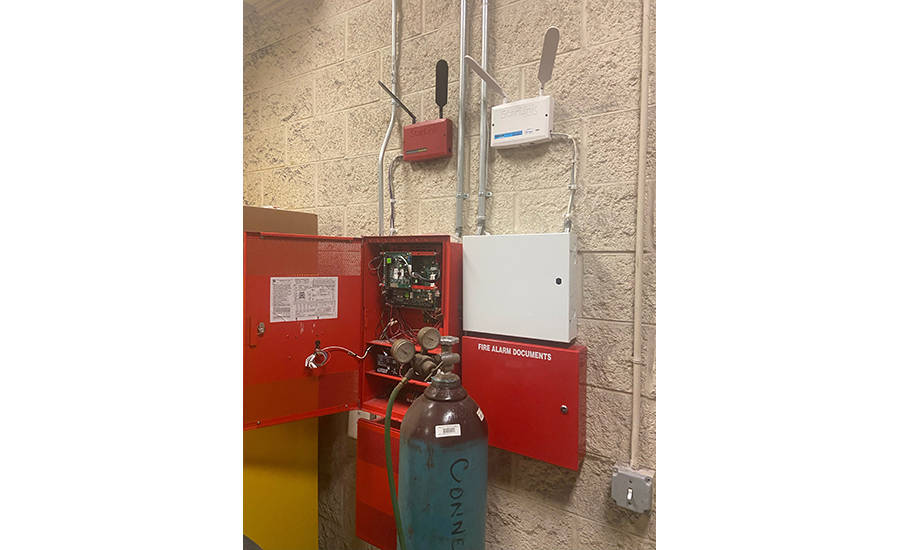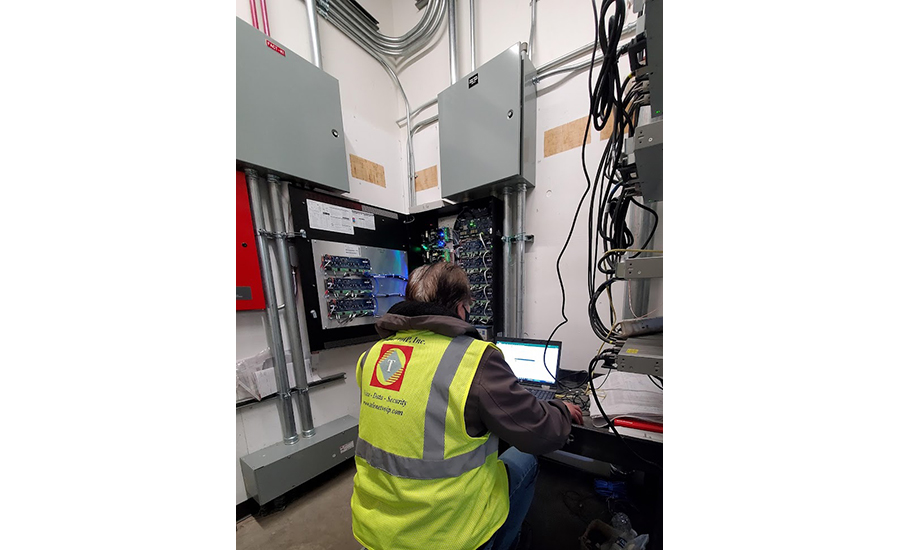If you are looking for the most succinct description of how industry professionals view the current state of the fire/life safety market, “cautiously optimistic” would be an accurate characterization. If not for a few real-world concerns — supply chain woes, labor shortages and looming recessionary headwinds — the prevailing sentiment would be considerably rosier.
According to SDM’s 2022 Industry Forecast, 40 percent of security professionals consider the state of the fire alarm market to be very good or excellent, while 46 percent consider it to be good, and 14 percent believe the state of the market is poor or fair. The forecast also found the number of contractors that currently offer/sell/install fire alarm products and services stands at 59 percent, a 12 percentage point jump in 2022 compared to the previous year. Of those not currently offering fire alarm products and services, 19 percent have plans to start offering them within five years.
Test your knowledge by taking the State of the Market FIRE ALARM Quiz
Ahead, we explore factors that are driving — and hindering — growth in the fire alarm market, along with the latest in codes, supply chain ramifications and more with several industry professionals from the integration and manufacturing communities.
2022: Recovery & Rising Prospects
Sources interviewed for this report entered 2021 still contending with lingering aftershocks from the COVID-19 shutdown the prior year. And yet the market’s resiliency — fueled in part by the code-driven necessity for fire alarms and life safety systems and services — proved to be durable across a range of customers with specialized needs. The ongoing communications transition brought on by 3G sunsets and the demise of plain old telephone service (POTS) lines has also helped buttress the industry during the worst of the economic calamity.
“I really expect growth to continue because of the current backlog of work, and the continued strong demand that my customers are telling me about,” says Duane Warehime, vice president sales, Southern region, NAPCO Security Technologies, Amityville, N.Y. “Everybody is complaining they can’t get enough people [due to the labor shortage]. But everybody’s busy. Everybody has work booked several months out. I think that’s going to continue for a while now.”
Current State of the Market
SDM asked, “How would you rate the current state of the market for fire alarm/emergency communications?”
Perception of the state of the fire alarm market showed marked improvement across the board in 2021 compared to 2020. // SOURCE: SDM 2021 AND 2022 INDUSTRY FORECAST STUDIES
Still to play out in the months ahead are the Federal Reserve’s plans to keep increasing interest rates until inflation is under control. Will the Fed’s strategic course cause a recession? Time will tell. But even a negative perception of the general economy could have consequences for the fire alarm market, Warehime suggests.
“What people believe, matters. If the media is telling them that there’s a recession, if they’re hearing it everywhere — even if they don’t see it in their own lives — they believe a slowdown is coming,” Warehime adds. “They are going to adjust their behavior and potentially delay purchases, like fire alarm upgrades or new construction projects.”
With so many market variables to track it will be incumbent for all businesses — integrators and manufacturers alike — to be constantly forecasting and modifying processes, says Jonathan Keener, marketing manager, Hochiki America Corp., Buena Park, Calif.
“Hochiki’s growth has improved substantially this year and we don’t see any signs of that changing,” he says. “We are expecting to finish this year outperforming our projections. Supply chain issues are still challenging, but little by little they are getting better. We surprisingly saw our highest number of trade show visits in 2022 in 19 years. And with momentum building in the construction industry, it seems reasonable that fire alarm product demand will increase as well.”
The fire alarm industry, including Honeywell, once again showed resiliency by persevering and adapting through the past couple of tumultuous years, expresses Dick Bauer, vice president of sales, Notifier, Honeywell Fire, Honeywell Building Technologies.
“Unlike many other industries where employees could work remotely, manufacturers and distributors needed to remain on the front lines,” Bauer says. “This pushed us to quickly adapt with new safety protocols and evolve our processes to focus on our customers’ challenges and goals, while keeping the changing landscape in mind. As with anything, the lessons learned in 2020 gave us a clearer path forward in 2021 and beyond.”

StarLink Universal Cellular Communicators (StarLink Fire Cell Communicator is red, at left top) installed in a city vehicle maintenance building in Michigan by Interstate Security. A NAPCO Firewolf fire alarm control panel is shown open. The system is capable of shutting off gas pumps when in alarm. // IMAGE COURTESY OF NAPCO
Communications Upgrades Drive Growth
George Brody, president of Atlanta-based Telguard, explains that in August 2019, the FCC released an order which in essence marks 2022 as the year in which telephone networks will no longer be required to maintain landlines and will in fact be allowed to deactivate and/or raise prices on existing POTS lines.
“Although the full impact of this is expected to be felt as the year ends and starting in 2023 from a service pricing and availability perspective, landline cutting continues to accelerate in the commercial market, especially with fire systems,” Brody says. “As the cutting continues to accelerate, manufacturers of cellular/internet fire communicators, such as Telguard, stand to benefit. Having the Telguard Commercial Fire Communicators both cellular and dual path units with UL864 and NFPA 72-compliant provides an easy POTS change out, lowers the monthly cost for the building owner, and provides RMR for the fire systems dealers and integrators.”
Daniel Rosales, senior director, technical services, Telguard, highlights the company’s collaboration with Honeywell to provide cellular alarm communicators, integrated with Connected Life Safety Services (CLSS), as an example of how the industry is bringing to market advanced communications and new services.
“CLSS is an innovative, all-in-one cloud solution built on Honeywell Forge, a powerful analytics platform that enables real-time data and visual intelligence for connected buildings,” Rosales explains. “CLSS equips fire systems installers and facilities managers to deliver enhanced fire safety services while maximizing the performance of Honeywell’s trusted detection and notification systems.”
Brandon Clig, sales manager for Rochester, Minn.-based Custom Alarm, explains CLSS can help increase fire system connectivity, improve alarm signal reporting detail and optimize the communication path of alarm signals. Rather than having to be onsite to determine the cause of trouble or supervisory signals, CLSS allows end users to review their current system status from an app or web browser. Custom Alarm, which also deploys CLSS with Notifier by Honeywell fire alarm control panels, is leveraging the service to create new recurring revenue.
“We found it to be pretty useful with facility managers,” Clig says. “On a Saturday night when they’re getting a call because of a dirty smoke head, they’re now able to pull it up on their phone and say, ‘OK, I can disregard that when the monitoring center calls, but we’ll address that on Monday. I don’t need to go out there at two o’clock in the morning.’ Just the ability through that app and through IP monitoring, how you can do it through cellular communication is really taking the next step forward. In the next five years phone lines are going to be completely gone.”
Communications upgrades of existing systems will continue to be a driver for new business for years to come, says NAPCO’s Warehime. “In many ways, we’ve benefited from the fact that a lot of alarm dealers have noticed this opportunity and really jumped on it. But there’s still a lot of opportunity out there,” he says. “And there are still a lot of people who don’t see it as big as we do.”
Warehime explains a big piece of the puzzle that a lot of people are missing is the dialer capture component — the ability to essentially connect to what used to be the phone jacks to the alarm panel.
“We can do that through the cellular radio, then forward the communications to the customer’s central station, in some cases completely ignoring the information that’s programmed into the alarm control,” he says.
Warehime illustrates this opportunity by explaining a fictional scenario: A large end user has 30 branches spread across six states. Over the years their facilities have been serviced by multiple companies using different fire alarm control panels.
“If you’re a large national account or one of these consolidating dealer companies, you can have the ability to service that entire market. You can walk in and put NAPCO radios on all the fire alarm panels and they can now deal with one company,” he continues. “That is a huge change in the marketplace. They can just walk in and take over customers without having to reinstall a whole new fire alarm system with all the additional components that are required, etc., for compatibility.”
Revenue Change Expectationst
SDM asked, “Compared to this year, how do you expect your company’s revenue in each of the following categories to change next year?”
The percent of respondents that anticipated fire alarm/emergency communications revenue would grow in 2022 ticked up 5 percentage points over predictions from the previous year. More than 1 in 2 respondents expected status quo performance. // SOURCE: SDM 2021 AND 2022 INDUSTRY FORECAST STUDIES
Hot Vertical Markets
For Nashville-based ACT Security’s fire alarm business, top line sales have continued to rise in 2022, with revenue up versus the prior year as manufacturers are now starting to deliver equipment, says Chuck Robinson, director of sales for the integrator’s commercial and government division.
“We are really focusing in on our contractor relationships and the multi-tenant improvement market. Our project size is smaller than previous years, but our volume is substantially higher,” Robinson says. “We are also focused on after-the-install services such as monitoring, annual inspections and service agreements. Our inspection portfolio has grown substantially in the last three years and continues to be an area of focus for our company.”
The resizing of office space is driving tenant improvement work, Robinson explains. Many office spaces are being reduced in size and new tenants are being brought in. What used to be a single office space is now being converted into two to three individual work places.
Robinson says as companies continue to evaluate their office needs, the tenant improvement market will continue to trend upward as companies allow leases to expire or renegotiate or sublet their spaces. “It will be interesting to see how sustainable or long-term it is as we watch the economy and construction markets, heading into what many believe could be a recession,” he adds.
Pleasanton, Calif.-based Sciens Building Solutions, a security and life safety integrator with a growing national footprint thanks to an aggressive M&A strategy, is also experiencing growth in office space and multi-tenant facilities, says CEO Terry Heath. The rising trend in this particular market niche has resulted from the movement of many companies into new areas, mainly during and after the COVID-19 pandemic.
“This can lead to temporary building vacancy in the cities they are moving from,” Heath says, “but also creates new opportunity for us: In the new cities and buildings they are moving into, as well as new companies moving into those vacated spaces, which potentially adds to our customer portfolio across the country. … We’re excited for the future because, as we grow, we can offer even more collaborative efforts to our valued clients. This can make their work more convenient by having one life safety provider across all their projects.”
With a rising population in and around its home base of Rochester, Minn., Custom Alarm is also increasingly finding the multi-tenant housing market a rich vein of new revenue through new construction and monitoring services. Providing fire alarms for houses of worship, based on occupancy classification, is another vertical the company is finding success with in 2022.
Adding Fire Services
SDM asked, “Are you offering, or planning on offering, fire alarm products and services?”
The number of contractors that currently offer/sell/install fire alarm products and services jumped 12 percentage points in 2022 compared to the previous year. Of those not currently offering fire alarm products and services, 19 percent have plans to start offering them within five years. // SOURCE: SDM 2022 INDUSTRY FORECAST STUDY
“Within the fire alarm industry there are a lot of different integrations that we can do with the lock downs and stuff like that,” Clig says. “That’s the key factor that has helped drive some of those sales. With life safety systems you can integrate different lockdown situations or building notifications within that fire alarm system. So it’s getting a little bit different than in years past with fire alarms. You once had a fire in the building and you wanted to get the notification out so everybody gets up out of the building. But now it’s more of like, 'OK, how can I also use this with different applications?'”

A commercial fire system installation utilizing the TG-7FS Communicator by Telguard. // IMAGE COURTESY OF TELGAURD
Telenet VoIP, an integrator, has been servicing the Southern California region for two decades, primarily in the education market, including K-12, community colleges and universities. Much like other sectors, there are ebbs and flows in the type, size and number of fire alarm projects that come to bid each year. This is very much tied in with the budgets and bonds school districts have for major modernization and renovation of the schools, explains Vice President Nick Payab.
The company’s project timelines are mostly between six months to three years, and based on the projects won in 2021 and prior, Telenet VoIP does not anticipate a large increase or decrease in fire alarm work for 2022. However, Payab says there are multiple factors that will contribute to potential growth going forward.
“New requirements in CO detection for schools will bring about larger fire alarm system designs,” he says. “Older systems are being upgraded for voice evacuation requirements. Overall, new NFPA guidelines create large growth potential on the fire alarm system marketplace.”
The phasing out of POTS lines and the sunsetting of older generation cellular services continues to disrupt school districts and other educational institutions across the nation, while providing new, long-term opportunities for security and life safety integrators.
“Due to the POTS issue, Telenet VoIP has implemented an AES mesh radio service so that we can eliminate both the use of POTS lines and the cellular dialers, and provide a proven technology that has been in use for several decades,” Payab says. “AES has been very supportive and helpful in assisting us to build the system. We are in the early stages of putting new accounts on the platform and looking at building a solid solution for all our fire alarm customers.”
In the emerging markets arena, Keener of Hochiki identifies facilities in the renewable energy sector as currently experiencing significant growth, which he expects to continue well into the future. “Wind, solar and battery energy storage systems [BESS] are good opportunities for many reasons,” he advises. “Many of these systems can benefit from fire protection. I think that will be enforced more and more in energy storage systems with NFPA 855 and UL 9540A providing a standard for all AHJs to follow for compliance of BESS installations.”

Telenet VoIP, an integrator serving the Southern California region, has experienced equipment back orders for as long as an entire year due to supply chain disarray. // IMAGE COURTESTY OF TELENET VOIP
No doubt sharing the sentiment of most all his industry brethren, Keener is looking forward to the return to where everyone was at the end of 2019, before the pandemic irrevocably impacted the entire world. Getting whole again and on solid footing for the future will be no easy trek, he expresses.
“Rising costs due to inflation will drive up the cost of fire alarm products. Labor shortages can impact schedules and workflow,” Keener postulates. “Competition among product manufacturers can impact the sales — and success — of any business. But regardless of the threats, fire alarm and life safety systems serve a valuable purpose. The industry must work hard and overcome all challenges so that this vital and potentially life-saving equipment can continue to be provided, installed, and maintained. Lives depend on it.”





